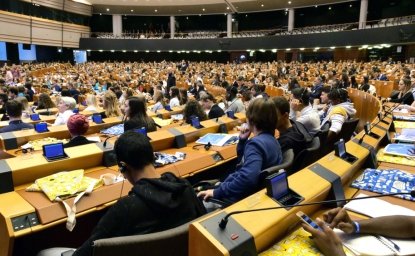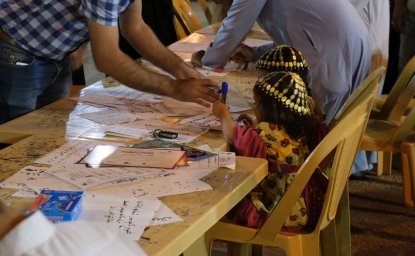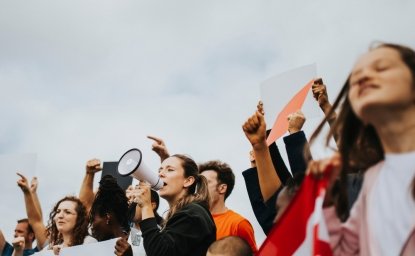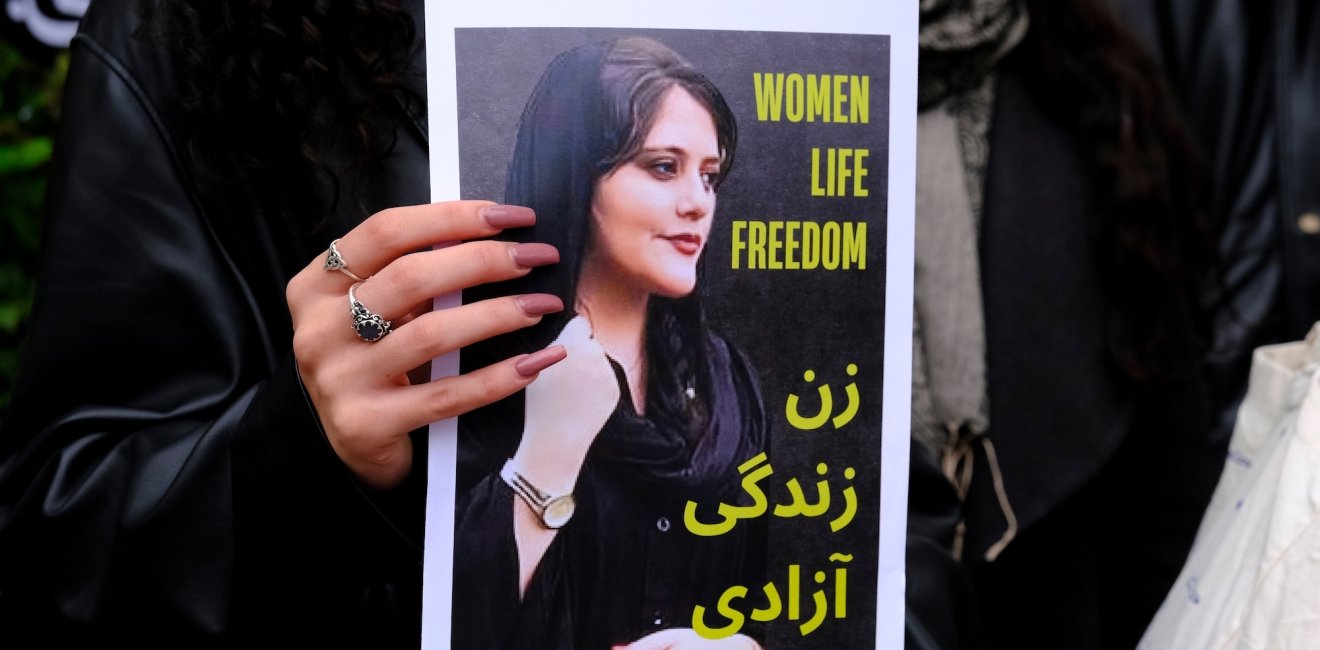
A blog of the Middle East Women's Initiative
This week, 40 days have passed since the death of Mahsa Amini, the twenty-two-year-old woman from the Kurdish region of Iran, while in police custody in Tehran. Her crime: disobeying the Islamic Republic’s dress code, requiring her to wear the hijab. Since Mahsa’s death, thousands have taken to the streets of the capital as well as 50 other cities across Iran to protest not only her death, but the hijab. They are calling for women’s rights and objecting to the theocratic regime itself and its autocratic rule.
It is the woman factor in these protests which has inspired women across the Middle East and North Africa region to speak up, protest for women’s rights, and stand tall in solidarity with the women of Iran.
Iran has seen waves of protests against the regime in the recent past, starting with the 2009 Green Movement. However, these protests differ in scope and because they are “led by women,” as Iranian scholar Haleh Esfandiari notes. It is the woman factor in these protests which has inspired women across the Middle East and North Africa region to speak up, protest for women’s rights, and stand tall in solidarity with the women of Iran.
Women across the region speak out
For many women across the MENA region, from Jordan to Bahrain and Egypt to Tunisia, the oppression and brutality that led to Mahsa’s death is a story that hits too close to home. Akin to the women of Iran who are organizing, mobilizing, and keeping the pressure on the government today, many women’s rights activists and women’s groups understand that they have the power to lead the change they want to see. “What women are doing in Iran today is an extension to women’s struggle for liberation elsewhere,” noted Samar Saeed, a historian and women’s rights advocate from Jordan. “In the past few years (2018 and 2019), women in Lebanon, Jordan, Sudan and Algeria protested against their oppression and demonization but also protested the political situation in those different contexts that hinder living in dignity and freedom for all people,” she added.
In many countries across MENA, footage of Iranian women demonstrating, cutting their hair or burning the hijab and chanting, “Zan, Zendegi, Azadi (women, life, liberty) were widely shared, including in Arabic, French and English. “Numerous Tunisian women answered the call to demonstrate in front of the Iranian cultural center in Tunis, to show solidarity with Iranian women,” noted Lilia Labidi, former Tunisian Minister of Women and Family Affairs. One political and civil rights activist in Tunis, Naila Qiddiya, told A24 News Agency in Tunisia that she and other women are “here in solidarity with women in Iran and against the tyranny they are subjected to, including forcing them to wear the hijab and suppressing their freedoms,” adding that their presence is also a reminder that Tunisian women “face the same threat after the adoption of the July 25th [Tunisian] constitution and under the new electoral system that excludes women and deprives them of their right to equality.”
Last month, Beirut also witnessed demonstrations in support of Iranian women and their struggle for freedom. Many protesters were clear to note that they are also protesting the patriarchy across the region. As one Lebanese protester noted, this is not merely about the hijab, rather it is “about women’s right to choose.” Hundreds of women in Kurdish-controlled Northern Syria staged a protest in support of the women of Iran and their fight against the oppressive regime and its repressive policies. A member of the Kongra Star women’s rights organization there noted they demonstrate to say “no to injustice, no to oppression and yes to women’s rights.”
In neighboring Afghanistan, women remain steadfast in their support of Iranian women and they too have taken to the streets, not only to support their neighbors but to protest Taliban rule and the violence women and girls are subjected on a daily basis, particularly after the September 30 suicide attack at a Kabul educational center in which 53 girls were killed. As Leila Nabizada, a young Afghan woman who works on youth issues in her country wrote to me, “most of the women lost their loved ones during the explosions and most of them lost their jobs, but beside all these pains and suffering, they are still protesting for the murder of a young woman who lived in our neighboring country.” She added, “it is honorable for us. It shows the strength, dignity and compassion of Afghan women.”
Old Wounds Opened
In Egypt, women’s groups likened what happened to Mahsa to what took place during the January 2011 revolution, in an incident known as the “Girl in the Blue Bra,” explained Radwa Elsaman, an Egyptian women’s legal expert. A young Egyptian woman who was protesting in Tahrir Square was dragged by Egyptian soldiers and stripped of her clothes, revealing her blue bra and bare skin. While many activists condemned what happened at the time, when the Iranian authorities claimed that Mahsa died due to an illness, many Egyptians were reminded of Islamist activists and conservative sheikhs (religious clerics) who pointed their finger at this young Egyptian woman asking, “Why was she even in Tahrir Square?”
Most of these repressive policies, especially when violence is involved, are done in the name of religion.
The hypocrisy in the approach from the religious establishment was another trigger for many in the region. Most of these repressive policies, especially when violence is involved, are done in the name of religion. In Bahrain, whose population is majority Shiite like Iran, Mahsa’s death sparked a “wide debate” about the wearing of the hijab. Wafaa Alaam, a Bahraini journalist told me that while women's groups “clearly expressed sympathy with Iranian women and their right to choose whether or not to wear the hijab,” conservative Shiite groups “launched a fierce attack against it, considering the hijab a red line that is not negotiable, adding that “wearing it is a settled issue as it is an order from God.”
A former Algerian Member of Parliament and women’s rights advocate Kahina Bouagach told me that, “while it is painful to find words for such a revolting act,” referring to the death of Mahsa and other young women in Iran in the last 40 days, she asked: “if such crimes against women’s freedom to choose are publicly owned (by these states) without any international intervention, then how many women are oppressed, in private, when they are behind closed doors?” In fact, according to UN Women, one in three women worldwide has experienced some form of gender-based violence, mostly by an intimate partner, and in the Arab world, “37 percent of women have experienced some form of violence in their lifetime,” with an alarming uptick during the COVID-19 pandemic.
Whether these acts of violence against women are on display in public or are tucked away in the name of private family affairs, the women-led protests in Iran and the solidarity shown across the MENA region by women’s rights activists are a brutal reminder of the entrenched patriarchal systems that continue to strip women of their basic rights and freedoms. They are also a beacon of hope, showing that women have the agency and capacity to tap into their own power and lead change, not only for girls and women, but for the entire society. That sentiment is what many women feel deeply in the region. I certainly do and I am inspired.
Author


Middle East Program
The Wilson Center’s Middle East Program serves as a crucial resource for the policymaking community and beyond, providing analyses and research that helps inform US foreign policymaking, stimulates public debate, and expands knowledge about issues in the wider Middle East and North Africa (MENA) region. Read more


Middle East Women's Initiative
The Middle East Women's Initiative (MEWI) promotes the empowerment of women in the region through an open and inclusive dialogue with women leaders from the Middle East and continuous research. Read more

Explore More in Enheduanna
Browse Enheduanna
What Remains for Aid: Women, Youth, and the Opportunity for Peace in the Middle East

How Education Can Empower Young Women in MENA

Empowering the Changemakers of Today: Young Women

